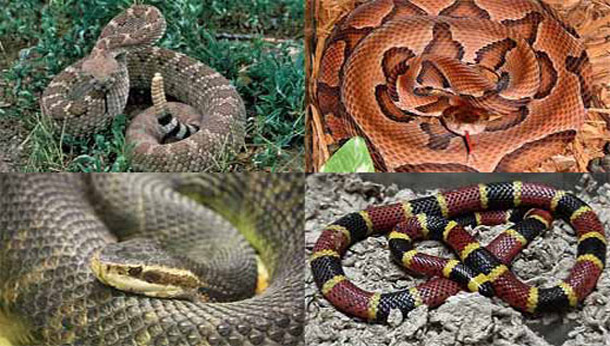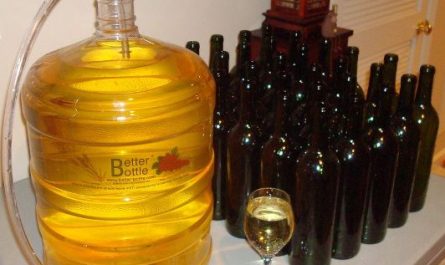Click Here To Join Our Telegram Channel for FREE daily tutorials!

For your safety, know these 4 poisonous (venomous) snakes, and what they look like – to avoid being bitten by one.
There are thousands of types (species) of snakes in the world, while more than one hundred species are found in North America – and some of them are poisonous (venomous).
The poisonous (venomous) snakes of North America fall into two groups:
Coral Snakes and Pit Vipers (which include Rattlesnakes, Cottonmouth, & Copperhead)
First, know that snakes only bite when they are provoked (typically), or when you’ve unknowingly startled them. By simply leaving them alone, you should be okay.
These dangerous snakes have a heat-sensitive sensory organ on each side of the head that enables them to locate warm-blooded prey and strike accurately, even in the dark.
Copperhead

The Copperhead, a pit viper, widespread throughout the United States, is responsible for most of the venomous bites.
Copperhead bites are painful, but rarely pose a serious threat to human life.
However, anyone who is bitten by a Copperhead should still seek medical attention as soon as possible.
They are usually a tan to copper color but can vary widely based on region.
Common are the patches of hourglass markings on its back and their copper-colored triangular looking head.
The Copperhead typically ranges from Massachusetts to Nebraska to Texas and the south-east United States.
Coral Snake

The coral snake is the most toxic of the four on this list.
Its venom is a powerful neurotoxin and unless you get prompt snake bite treatment, the bite will shut down your nervous system, your heart will stop beating, and you will likely die.
The coral snake is identified by the red, yellow and black bands that ring the length of its body, and it has a blunt black snout.
The Coral snake colors are always red, then yellow (thinner band), then black.
Coral snakes and the similar looking (but harmless) King snake (red snout), are often mistaken for each other.
Here’ how to remember:
“Red touch yellow, kill a fellow.” (Deadly Coral snake)
“Red touch black, friend of Jack.” (Harmless King snake)
The Eastern Coral Snake typically ranges from North Carolina through Florida and along Mississippi.
The Western Coral Snake typically ranges from Arizona.
The Texas Coral Snake typically ranges in (yes, you guessed it — Texas). Also Arkansas and Louisiana.
Cottonmouth

The Cottonmouth also called “water moccasin”, is an aggressively fast, nasty, cranky pit viper with large venom glands.
They have a thick, heavy body and are brown, olive to grayish/black with a flat-topped head.
The Cottonmouth’s bite is far more serious than that of the Copperhead and can be fatal.
When annoyed, the Cottonmouth tends to stand its ground and may gape repeatedly at an intruder, exposing the light “cotton” lining of its mouth.
The Cottonmouth typically ranges from Virginia to Florida to Texas to Missouri.
Rattlesnake

Probably the best-known snake in the world, the Rattlesnake is a pit viper found almost everywhere in the United States and is capable of a deadly bite.
Its trademark rattle strikes fear into anyone who hears it.
With their huge pair of fangs, and while there are many varieties of rattlesnakes.
The Eastern Diamondback Rattlesnake… Give this rattlesnake a wide berth; it is the most dangerous snake in North America! Although the venom of this species is similar to that of most rattlers (and less potent drop-for-drop than that of the coral snakes), a large Eastern Diamondback is capable of delivering a large amount of venom deep into the flesh of its victims. This snake is also known for standing its ground when threatened. They range from North Carolina to Florida. Also Mississippi and Louisiana.
The Western Diamondback is one of the more deadly rattlers, nearly as much as the Eastern Diamondback, and is most often visualized from pictures and Western movies. They range from California to Arkansas to Mexico.
The Timber Rattlesnake is in abundance and ranges from the northeast through Florida, Minnesota, and Texas, and is commonly found on Wooded hillsides and rocky outcrops. It has a slightly more laid-back reputation but makes no mistake, it is deadly.
Further reading:
A Field Guide to Venomous Animals and Poisonous Plants
If you enjoyed this article, you might be interested in learning about the snakes in Hawaii – and how they got there! Don’t worry though, generally the snakes inhabiting Hawaii are not as deadly or venomous as the ones on this list!

By Ken Jorgustin
This Crazy Off Grid Device Literally Makes Drinkable Water From Fresh Air:
According to NASA, the U.S. is expecting a 100-YEAR LONG MEGADROUGHT.
It's already begun. Ask the farmers in California. They know.
Every survivalist knows that water is of critical importance. You NEED an independent water source that you can count on!
As an interesting "survival rehearsal" - imagine that you turned the tap on right now and nothing came out. How long would you last?
But what if there was another water source literally hidden in plain sight. That's right, I'm talking about the atmosphere!
The amazing thing about getting water from the natural moisture in the air... is that it is ALWAYS available.
This gives you real water security!
Learn more about how to tap into "Nature's secret water reservoir" and stay hydrated when TSHTF!
Watch the video:

After 47 years of studies and countless brain scans done on more than 2,400 tinnitus patients, scientists at the MIT Institute found that in a shocking 96% of cases, tinnitus was actually shrinking their brain cells.
As it turns out, tinnitus and brain health are strongly linked.
Even more interesting: The reason why top army officials are not deaf after decades of hearing machine guns, bombs going off and helicopter noises…
Is because they are using something called "the wire method", a simple protocol inspired by a classified surgery on deaf people from the 1950s...

I Can't Help Showing This Off:
If you haven't heard of Claude Davis yet do yourself a huge favor and watch this video.
One of the smartest guys I ever had the pleasure of meeting, Claude set-up a unique prepping system that changed his life forever.
I already tried it myself and let me tell... you I was completely blown away... His surprising tactics could make your life easier and give you the peace of mind you deserve.
Don't just take my word for it... watch his short video and decide for yourself.

Most People Don't Have The Guts To Try This:
An amazing discovery in an abandoned house in Austin, Texas: A lost book of amazing survival knowledge, believed to have been long vanished to history, has been found in a dusty drawer in the house which belonged to a guy named Claude Davis.
Remember... back in those days, there was no electricity... no refrigerators... no law enforcement... and certainly no grocery store or supermarkets... Some of these exceptional skills are hundreds of years of old and they were learned the hard way by the early pioneers.
>> Click here to find out about them now
We've lost to history so much survival knowledge that we've become clueless compared to what our great grandfathers did or built on a daily basis to sustain their families.
Neighbors said that for the last couple of years Claude has tried to unearth and learn the forgotten ways of our great-grandparents and claimed to have found a secret of gargantuan proportions. A secret that he is about to reveal together with 3 old teachings that will change everything you think you know about preparedness:
>>> Click Here To Watch His Short Video <<<

More Off-Grid And Survival Resources:

What REALLY Happens When You Bury a Shipping Container? (Hint: It's A Bit Crazy...)
Shipping containers are all the rage - but if you are thinking about buying one, you MUST watch this video first:
There's a general belief that if you bury a shipping container you can create an awesome root cellar / storm shelter / survival bunker.
But is a shipping container strong enough to handle the pressure?
Watch the video to see what happens:
What Really Happens When You Bury a Shipping Container? (Click To Watch Video)









